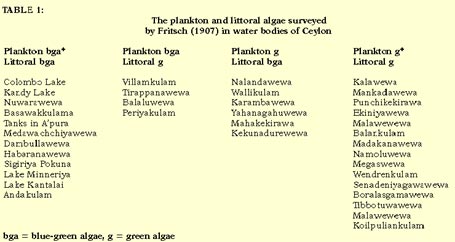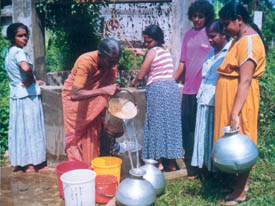|
DAILY NEWS ONLINE |
|
|
|
OTHER EDITIONS |
|
|
|
|
|
|
|
|
|
OTHER LINKS |
|
|
|
|
|
|
 |
Is the water we drink, safe?The National Water Supply and Drainage Board (NWSDB) is the principal organisation entrusted with the responsibility of supplying safe drinking water to the public of Sri Lanka. It uses natural resources of water such as rivers, reservoirs and irrigation tanks as sources of supply for their water supply schemes in both urban and rural areas. Among these, the ancient irrigation tanks are the main sources of supply predominantly in the dry zones of North Central, North western, Southern and Eastern Provinces of Sri Lanka.
The principal steps in a supply scheme include the raw water being subjected to aeration, flocculation and settling, filtration and chemical treatment (very often chlorination) prior to it being stored in a high rise tank for distribution. The water that is supplied is meticulously analyzed for high quality with respect to PH, odour, colour, taste, electrical conductivity, coliform bacteria etc. All these precautions are taken and efforts made to maintain standards set by the World Health Organisation in order to ensure that the water supplied for drinking purposes is safe and pure. This article is written to highlight a lurking danger in the water thus supplied primarily due to ignorance among most of us regarding the possible presence of some little known group of toxins in water. The purpose of this article is to create awareness among the public and the relevant authorities with the hope that necessary steps would be taken to ameliorate the situation wherever it occurs.
The hytoploankton population in a relatively unpolluted water body would be low and normally contain approximately equal numbers of greenalgae, blue-green algae and diatoms. On the other hand, when a water body gets polluted its total algal population increases but its diversity decreases and often blue-green algae become predominant. Thus the reduction in the diversity of species among the phytoplankton population of water body can be taken as an initial indicator of pollution. When large inputs of non-toxic pollutants flow into a water body the water becomes hyper-eutrophic, and leads to explosive growth of algae called 'algal blooms'. Such massive growths are often associated with fish kills, intolerable bad smells and generally make the water unusable. A classic example in Sri lanka is the Beira Lake in Colombo that is eternally dark green in colour due to the dominant presence of species of blue-greens such as Microcystics and Arthrospira.
Algae in the irrigation tanks, lakes and reservoirs in Sri lanka have been surveyed and recorded since the beginning of the 20th century. One of the earliest publications is that by W. West and G.S. West in 1902 entitled 'A contribution to the freshwater algae of Ceylon' that appeared in the Transactions of the Linnean Society, London. Having examined samples collected Between Anuradhapura and Kandy, between Kosgoda and Uragasmanhandiya, Hakgala, Hanwella, Henarathgoda, Kekunandara, Matara, Panadura, Peradeniya, Tibotuwa and Yadagamuwa they describe 30 species of blue-green algae belonging to 18 genera under 6 families. The famous algologist Professor F.E. Fristch has visited Sri Lanka as far back as 1907. During this visit he has travelled along the west and southwest of the country through Negombo, Colombo, Panadura, Kalutara, Bentota, Ambalangoda, Matara to Hambantota and North through Kurunegala, Dambulla, Sigiriya, Anuradhapura, Habarana, Vavuniya to Trincomalee. having paid a brief visit to Nuwara Eliya, Pidurutalagala and Hakgala, he has spent a fortnight at Peradeniya. In two classical research papers published in the Royal Society of London and Annals of Botany, London, he has reported his findings which give a vivid picture of the algae present in most of our ancient irrigation tanks in the dry zones of Anuradhapura and Polonnaruwa. He made the general observation that the inland freshwater of Ceylon have a preponderance of blue-greens due to high water temperature which results in low dissolved oxygen and carbon dioxide. The plankton and littoral algae in the different lakes and irrigation tanks observed by Fritsch are summarised in Table 1. Fritsch also reported that the dominant blue-green algae in the irrigation tanks of Ceylon were Oscillatoria, Lyngbya, Tolypothrix, Scytonema, Hapalosiphon and Rivularia. Lyngya majuscula was exceedingly common in Nalandawewa, Tissawewa, Balankulam, Habaranawewa, Medawachchiyawewa and dominant in Nalanda and Anuradhapura. Basawakkulama was dominated by Gloeotrichia rabenhorstii. Lake Kantali was dominated by G. natans and Lyngbya aeruginosa-coerulea. What is evident from these reports is that the dominant blue-greens recorded from our major irrigation tanks during the early 20th century are mostly non toxigenic species? Dr. W.K. Hirimburegama of the University of Colombo presented data from a two month survey he has conducted on the Beira Lake in Colombo in 1993. The main features of his presentation are: * Only two genera viz: Microcystis and Arthrospira have been recorded. * No green algae were observed. * In this lake, Costa and De Silva (1978) have reported the presence of 33 genera of phytoplankton algae in 1978 and a survey conducted in 1990 by the National Aquatic Resources Authority has recorded 17 genera. * This being reduced to two genera in 1993 is a clear indication of increased pollution due to hyper-eutrophication. * The author considers the present state of lake to a 'Facultative waste treatment pond' where aerobic conditions are provided by cyanobacterial photosynthesis and wave action. What is evident from the foregoing information is, that most of the inland water bodies of Sri Lanka (some of which are currently used as sources for water supply schemes) have a dominant presence of potentially toxin producing blue-green algae (cyanobacteria). The term 'potentially toxin producing' is used because the mere presence of these algae does not mean that toxins are present. Cyanotoxins are secondary metabolites and are produced by the organisms as and when necessary. The exact mechanisms that trigger off toxin production are not well established, but with the death of an algal bloom, the risk of release of toxins from decomposing algae is very high. Cyanotoxins (blue-green algal toxins)Presentations made by two Australian scientists Dr. Glen Shaw and Dr. Ross Saddler, at the PGIS symposium (1998) provide good descriptions of cyanotoxins and these are summarized below: It is evident from this Table that these toxins are mostly hepatotoxins and neurotoxins. They are thermostable and therefore cannot be destroyed by boiling. They are cumulative and hence can accumulate in small amounts over a period of time before any ill-effects are manifested. Epidemiological studies conducted in the Guangxi province in China have shown that a high incidence of primary liver cancer correlated with the consumption of water containing microcystins. It is pertinent to conduct such studies in the dry zones of Sri Lanka where the population consumes water from irrigation tanks that have a predominant presence of potentially toxin producing cyanobacteria. A number of methods are available for the detection of these toxins. Bioassays using experimental mice, immunoassays based upon antigen/antibody reactions have been developed to determine microcystins in water. Laboratory techniques based upon High Pressure Liquid Chromatography (HPLC) are commonly used in the detection and estimation of these toxins. Dr. L. P. Jayatissa has used such techniques in the laboratories of Dr. Linda Lawton to detect and quantify cyanotoxins in samples collected from Sri Lanka during his stay at the Robert Gordon University, Aberdeen, in Scotland. All this evidence show that most of the irrigation tanks in Sri Lanka possess potentially toxin producing algae and there is a lurking danger that we may be ignorantly poisoning our population by way of using these water bodies as sources for water supply schemes. Unfortunately the country does not have a single facility for the routine detection and estimation of these toxins. It is imperative that such a facility is established by the NWSDB as a matter of urgency. Possible remedial measuresExcessive chlorination and treatment with ozone have been found to be effective detoxicants, but these are costly when applied on large-scale treatment plants. Besides, the side effects of consuming water with high levels of such chemicals could also be injurious to health. The preponderance of toxigenic algae in water is a result of eutrophication and any measures taken to minimize inflows of nutrients and their accumulation in water bodies will reduce algal growth. Establishment of wetlands at the points of pollutant inflows can effectively minimize the eroded sediments with their nutrients reaching the main water resource. Stabilization of river banks and tank bounds with permanent vegetatious that absorb significant amounts of nutrients also reduce eutrophication. Minimizing human activities around water bodies, or at least setting apart designated protected areas that enable the re-establishment of natural aquatic vegetatious which provide ecological niches for the development of adequate populations of algal consuming micro-fauna and species of fish would keep the development of excessive algal populations in check. This type of bio-remedial methods has been successfully adopted in certain foreign countries to ameliorate pollution of aquatic ecosystems. The author had the opportunity of visiting laboratories of the National Centre for Environmental Toxicology in Brisbane, Queensland, Australia and the laboratory of Dr. Linda Lawton, of the Robert Gordon University in Aberdeen, Scotland, U.K. Extensive research programmes are in progress in these institutions on toxigenic algae and certain Sri Lankan scientists are also actively engaged in these studies. While Dr. Wasantha Wickremasinghe is working as a senior scientist at Brisbane, Dr. L. P. Jayatissa, Senior Lecturer in Botany from the University of Ruhuna has returned after spending a sabbatical year at the Robert Gordon University. It has been reported that photocatalytic oxidation in the presence of titanium dioxide can breakdown most algal toxins and certain bacteria capable of bio-degradation of cyanotoxins have also been isolated. During the recent visit of the author to the laboratory of the Robert Gordon University, Dr. Linda Lawton showed a keen interest in collaborating with scientists in Sri Lanka to study toxigenic algae in our water bodies with the objective of ameliorating this problem. We have certain local scientists such as Dr. L. P. Jayatissa (a trained cyano-toxicologist), and Professor E. I. L. Silva at the IFS (an experienced limnologist) who could join the engineers and the chemists of the NWSDB to launch a research programme with the objective of detecting the presence of algal toxins in water resources and seeking remedial measures for them. Highest priority should be given for the establishment of at least one laboratory under the NWSDB for the routine testing of water for these toxins. This feature article has been written after much thought not with the intention of criticizing or blaming any organization, but to create awareness to a national problem that has received little or no interest primarily due to ignorance and lack of information on these little known toxins. |
|
|
|

 Photosynthetic micro and semi-macro organisms collectively called
algae are of common occurrence in any aquatic ecosystem. Thus all
sources of water will contain some algae but they tend to developing to
large populations particularly in stagnant and slow moving water bodies
such as lakes, ponds, reservoirs and irrigation tanks. The free swimming
and floating population of algae, diatoms and blue-green algae (now
called cyanobacteria). Besides these, the dinoflagellates represent an
important component of the phytoplankton, particulary in marine and
lagoon ecosystems.
Photosynthetic micro and semi-macro organisms collectively called
algae are of common occurrence in any aquatic ecosystem. Thus all
sources of water will contain some algae but they tend to developing to
large populations particularly in stagnant and slow moving water bodies
such as lakes, ponds, reservoirs and irrigation tanks. The free swimming
and floating population of algae, diatoms and blue-green algae (now
called cyanobacteria). Besides these, the dinoflagellates represent an
important component of the phytoplankton, particulary in marine and
lagoon ecosystems.

